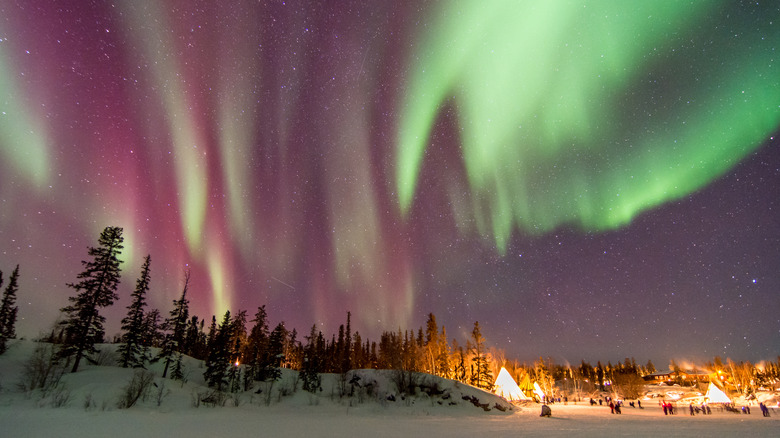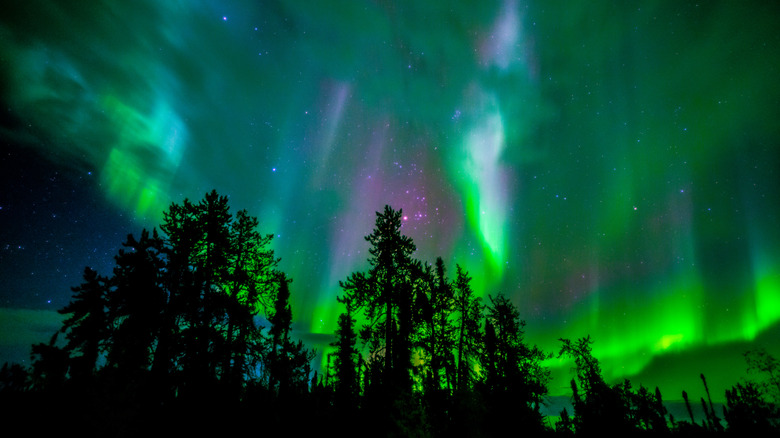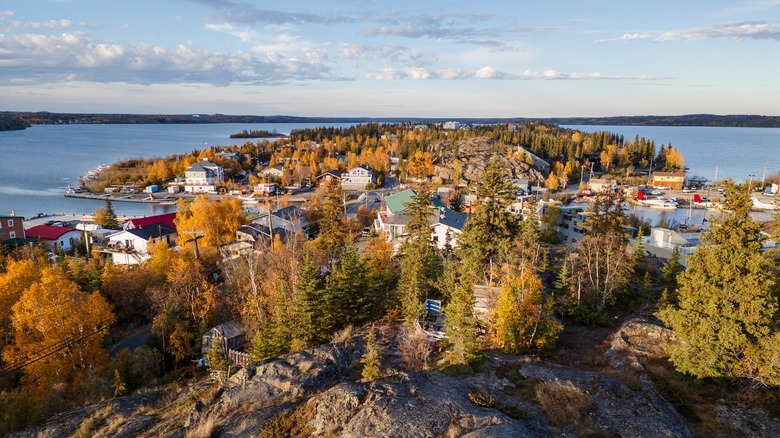One Of Canada's Best Places To View The Northern Lights Transforms Into A Fall-Colored Haven
The northern lights, or aurora borealis as they are known in the Northern Hemisphere — not to be confused with aurora australis in the Southern Hemisphere — are an incredible natural phenomenon and a true spectacle to witness firsthand. Appearing as multi-colored ribbons of light that dance through the sky, the Northern Lights are caused by particles energized by solar storms reacting with the Earth's atmosphere. Named as the number one bucket list activity by Forbes, travelers are more likely to successfully sight the Northern Lights in polar regions where solar activity is strongest. It's little wonder that so many adventurous travelers "chase the lights," a term used to illustrate their elusiveness.
The best global locations to witness the Northern Lights are Norway, Iceland, Greenland, Sweden, Finland, and Canada. The Northwest Territories of Canada, in particular, are an idyllic destination for those wanting to watch the Northern Lights without venturing as far as Europe. Yellowknife, a traditional Canadian mining town, is revered as one of the best places to see the Northern Lights. It is also a gorgeous travel destination in its own right, boasting stunning lakeside views, incredible hiking trails, and quintessential fall natural landscapes worthy of sharing on Instagram.
Where, how, and when to see the Northern Lights in Yellowknife
The best time to catch a glimpse of the elusive aurora borealis in Yellowknife is between mid-November and early April, when the skies are dark, clear, and solar activity tends to be greater. Should you visit in the mid-April through to August, you may be disappointed, as the area experiences a midnight sun period (continuous daylight) due to its location within the Arctic Circle. For those wanting to avoid freezing temperatures, September is not only picturesque due to the changing colors and beauty of Yellowknife's natural surroundings, but you also avoid the freezing temperatures the city experiences in the depths of winter, sometimes reaching as low as -40 degrees Celsius.
Northern Lights Tours is a highly rated tour operator local to the area. Their tour costs $85 Canadian (about $63 USD) per person, reduced to $75 Canadian (about $56 USD) if you book for more than one night. The tour includes visits to multiple locations where sighting conditions are optimal, professional photography services, and hot drinks and snacks. The benefit of an organized tour like this one is that the team is knowledgeable about the area and likelihood of a sighting — essential for taking in the beautiful views of the Northern Lights, especially since seeing them is never guaranteed. If you'd prefer to go looking for the aurora yourself, the local website Yellowknife Online has kindly listed all the best spots to view the Northern Lights in the city and surrounding area, complete with maps for easy navigation. Hiring a car would be your best bet to get around; Hertz Car Rental and Budget Car Rental are both reputable companies in the city.
Witness the majesty and colors of fall in all its glory in Yellowknife
If you're already in the area waiting for a northern lights sighting at night, why not make the most of your visit by seeing what else Yellowknife has to offer? A haven for outdoor enthusiasts, Yellowknife is a flourishing fall getaway destination. Yellowknife's Old Town is a picturesque part of the city, showcasing its rich history and heritage. One Google review said: "This part of the city has a nice old/northern vibe and is a photographer's dream. The lakefront is one of the best spots in the world for seaplane spotting, and the Bush Pilots Monument provides beautiful panoramic views of the city ... and the surrounding islands." At the Yellowknife Historical Museum, you can learn more about its gold mining backstory. The museum is open from Tuesday to Saturday, and entry is free. The Great Slave Lake is a must-visit no matter the season, but it looks particularly pretty in the fall when you can catch the blur of brown, orange, and yellow reflections of trees that surround the lake edge.
Hiking enthusiasts will find themselves spoiled for choice with trails that showcase the spellbinding natural beauty of the area. The Prospector's Trail is a scenic — often muddy — two-hour loop that takes you around a rocky area where gold miners once resided. The Frame Lake Trail is another popular option, taking you on a 4 mile loop. The eastern part of the trial will take you through a beautiful boreal forest, full of spruce and pine trees. The other half is more rugged, allowing you to spot local wildlife species like coyotes and muskrats, as well as various shorebirds and water birds. Hikers should take care exploring trails, as black bear sightings are not uncommon. Packing bug spray and wearing sturdy, waterproof footwear is also advised.


